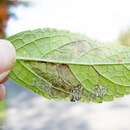Comprehensive Description
(
Inglês
)
fornecido por Memoirs of the American Entomological Society
Bucculatrix eupatoriella Braun (Figs. 25, 26, 130, 131, 131a.)
1918. Bucculatrix eupatoriella Braun, Ent. News XXIX: 247. Type 2, Cincinnati, Ohio [A.F.B.Coll.].
Face yellow, tuft ocherous in front, shading to reddish brown posteriorly ; eye-caps small, yellowish, antennal notch in male slight, stalk brown, indistinctly annulate. Thorax and fore wings bright brownish ocherous, occasionally approaching a uniform brown ; markings brilliant silvery. An oblique silvery streak at basal third and a second at two-thirds of costa, between which the ground color may be somewhat darker especially at the inner margin of the second streak ; on dorsal margin, a little basad of the first costal streak, a curved silvery spot, followed by a large patch of dark brown raised scales ; opposite the second costal streak, a pair of nearly confluent silvery dorsal streaks, the first margined inwardly, the second outwardly with black-tipped scales ; in cilia above apex, a broadly triangular creamy white spot ; at apex, a small silvery transverse spot, followed by a minute black spot at extreme apex ; cilia gray, with a row of dark brown-tipped scales extending through them from the white costal spot to dorsum. Legs gray-brown, base and apical fourth of posterior tibiae and spurs blackish, mid-portion and hairs whitish, tarsal segments dark-tipped. Abdomen fuscous above, lustrous yellowish white beneath.
Alar expanse 5 to 6.8 mm.
Male genitalia (fig. 130). Harpe slender, broadly expanding at apex, cucullus bilobed, each lobe armed with strong setae; socii setose, diverging, tapering to pointed apices ; uncus present, hood-like ; anellus elongate, contracting and weakly sclerotized toward apex ; aedeagus tapering, curving to the two-valved aperture ; vinculum broadly rounded. Scale sac present.
Female genitalia (figs. 131, 131a). Ventral anterior margin of ostium strongly sclerotized, posteriorly the lateral margins terminating in free curved pointed projections directed obliquely ventrally; segment 8 lateral to ostium densely scaled ; signum the typical ring of spined ribs, much wider ventrally.
Specimens examined. — 33, representing both sexes.
Ohio : Cincinnati, 2 type, 23 paratypes, rearing record B.955, from larvae and cocoons on Eupatorium perfoliatum L., collected August 13, producing imagoes from August 16 to August 24, 1917 (A. F. Braun) [A.F.B.Coll. and A.N.S.P.]; 2 5 paratypes, August 3. 1917, and September 1, 1905 (A. F. Braun) [A.F.B.Coll.]; Adams County, 1 3,3 2, rearing record B.955, from larvae on Eupatorium perfoliatum L., imagoes August 21 to September 12, 1928; Grant Lake, Brown County, 2 2 , rearing record B.2275, from larvae on Eupatorium perfoliatum L., collected August 28, imagoes September 18 and September 22, 1957 (A. F. Braun) [A.F.B.Coll.].
North Carolina: Balsam, Jackson County, 1 2, July 22, 1911 (A. F. Braun) [A.F.B.Coll.]. A single leaf of the food plant may contain twenty or more of the long, linear and much-contorted mines. The larvae on leaving the mines form scattered small eaten patches with the upper epidermis intact; later the leaf may be riddled with holes when a number of larvae feed on a single leaf. The short white cocoons, with four well-defined ridges and an inconspicuous ridge on either side, and well-differentiated anterior section in which only the two central ridges are welldefined, are commonly spun on the underside of the leaf, usually against the midrib.
Besides the late summer generation of which the larvae are extremely plentiful, as described above, there is probably a later generation, passing the winter in the pupal state with imagoes emerging in the spring. A third generation, from eggs laid on the food plant in spring, consists of few individuals, the moths appearing in early July.
B. eupatoriella is easily distinguished both by wing pattern and genitalia from all described North American species. Its nearest ally is B. polymniae new species.
- citação bibliográfica
- Braun, A.F. 1963. The Genus Bucculatrix in America North of Mexico (Microlepidoptera). Memoirs of the American Entomological Society vol. 18. Philadelphia, USA
Bucculatrix eupatoriella: Brief Summary
(
Inglês
)
fornecido por wikipedia EN
Bucculatrix eupatoriella is a moth in the family Bucculatricidae. It is found in North America, where it has been recorded from Ohio and North Carolina. It was described in 1918 by Annette Frances Braun.
The larvae feed on Eupatorium perfoliatum. They mine the leaves of their host plant. Pupation takes place in a white cocoon.
- licença
- cc-by-sa-3.0
- direitos autorais
- Wikipedia authors and editors

